As you might know, new cat breeds are being continuously developed by breeding catteries around the world with the hope to get acknowledgment from a national or international cat registry.
In the last years, not many new breeds have emerged or have been accepted by the major breed registries as cat breeds don’t just occur naturally anymore, and the breeders try to establish new breeds by working with the existing ones in forming new designer breeds, line breeds, and hybrid breeds that can be hard to accept by the cat fancier associations as they do not meet certain breed regulations. But I will tell you more about that later.
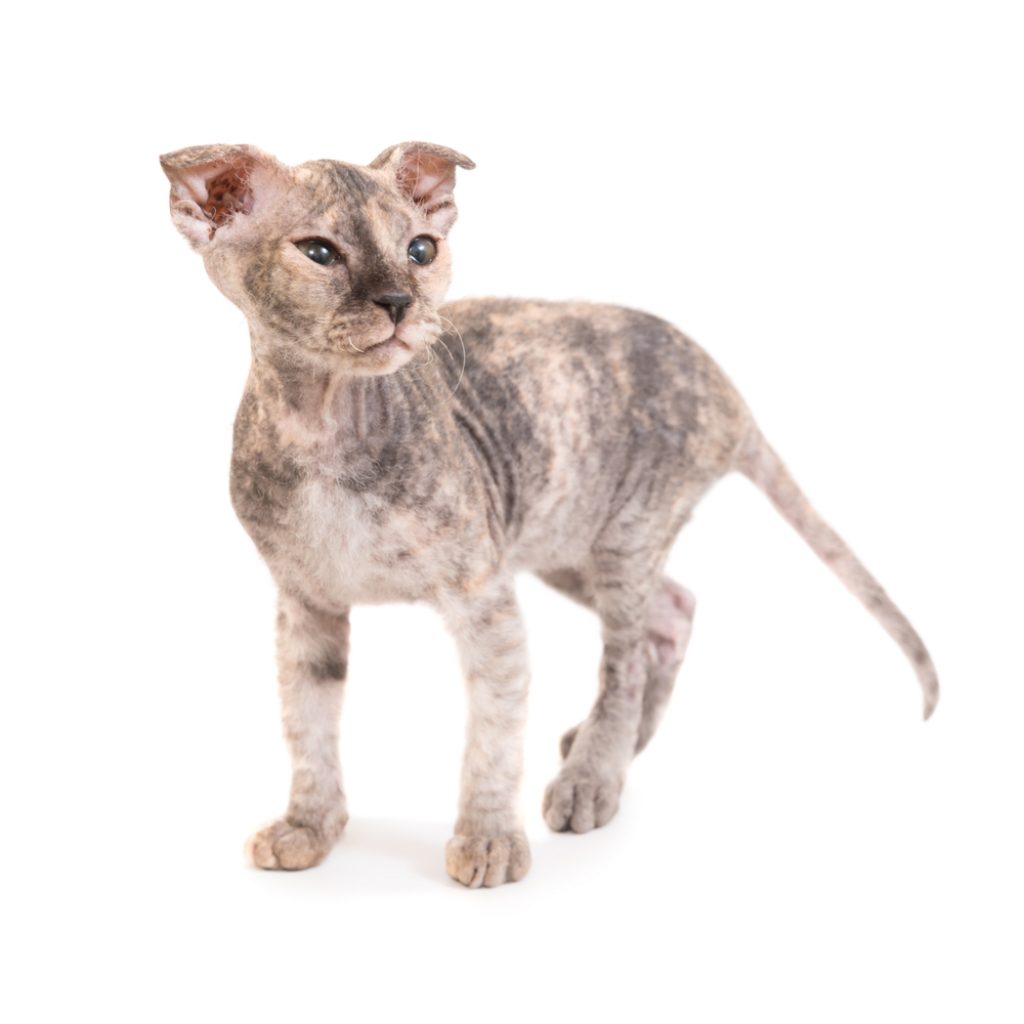
In this article, you will find ALL the new breeds of cats recently added to the most important cat fancier associations in the World, sorted by the year they gained last recognition, and the tops will be updated as soon as new information will emerge.
Top 10 newest cat breeds
This top contains the latest 10 fully accepted new cat breeds that acquired a championship status in at least one of the major cat registries of the World.
1. Lykoi
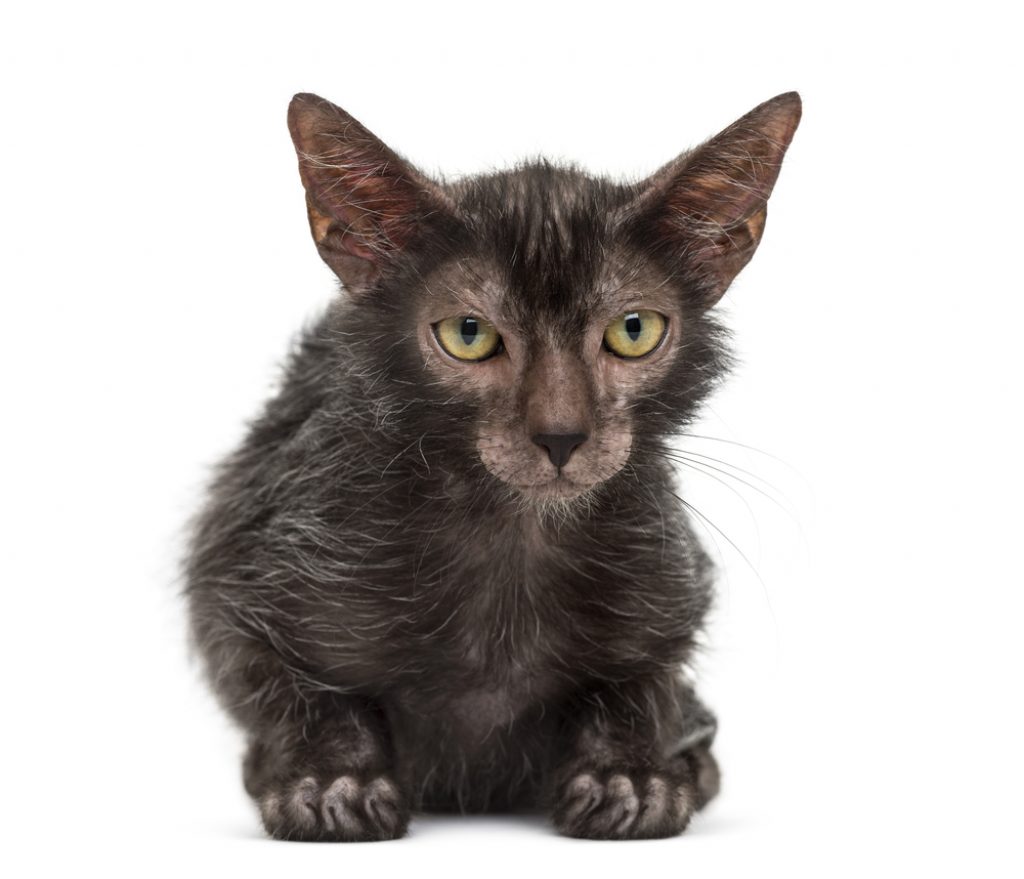
The Lykoi is a new breed of cat that was first discovered in 2010 in a feral colony in the USA and is a natural mutation from a domestic shorthair that looks like a ‘werewolf’, even the name itself Lykoi means “wolves” in the Greek language.
The Lykoi was established as a breed in 2011 and registered first with TICA- The International Cat Association in 2012, proceeding with registration in other cat fanciers associations. The breed was recognized as a Full Championship Breed in May 2017 with TICA and is now able to compete against other breeds in shows. In The Governing Council of the Cat Fancy (GCCF) they were granted the first stage of recognition in October 2017, and Preliminary recognition in February 2020. The Lykoi passed their Miscellaneous level with Cat Fancier Association in 2018 and gained the Provisional Level in May 2020, missing just one level to be fully recognized by the CFA. The pedigree is not recognized yet by FIFe (Fédération Internationale Féline) but is admitted by World Cat Federation (WCF).

The unique look of the Lykoi has become quickly popular with cat enthusiasts because of their shocking appearance, being called the wolf cats stirring amused reactions at a first glance. They have a strong prey drive when they play and like to stalk and pounce and also they have dog-like attributes because they like to fetch and chase. The Lykoi is a very intelligent, friendly, and loyal breed that bonds well with people and other pets.
2. Toybob

Toybob cats are a naturally diminutive new cat breed that originated in Rostov, Russia, and are seemingly remaining kitten-sized even as adults and have a kinked bobtail, but they are not to be confused with miniature cats.
In 1983 Elena Krasnichenko adopted a male stray cat that looked like an old-style Siamese, with a short kinked tail, and two years later, her mother adopted another stray cat, a female with seal point fur colorations and a curled bobtail. In 1988 a kitten of the two stray cats is born, a small bobtailed male cat named Kutciy, who becomes the originator of the Toybob breed.
The breed was given the name Skif-Thai-Don or Skif-Thai-Toy-Don in the 1990s and is registered in a few Russian cat associations. It is renamed ‘Toybob’ by WCF judge and feline book author Dr. Olga S. Mironova in 1994.
Toybobs gained their Championship Level in a few Russian cat associations in 2010. After the breed was genetically tested in 2016 to reveal they are not related to any existing bobtail breeds with the same genetic mutation, the breed received its first international Championship Status with WCF in January 2017 followed by another Championship Status with Cat Fanciers’ Federation (CFF) in 2018. Toybobs also acquire the Preliminary New Breed status by TICA in 2017 and 2019 the non-competitive Miscellaneous Class level with CFA, working towards championship level advancement.
The Toybob is a small, cuddly, charming, and playful cat but not as active as other breeds. Loving, social, intelligent, and affectionate cat, the Toybob likes to follow you everywhere you go and supervise everything you do. Plus they are making every cat lover’s wishes come true by remaining forever kitten-sized!
3. Thai

The Thai or Wichien Maat, also known as the “Old Style Siamese” is newly renamed but actually, an old cat breed also shown in Tamra Meow books of Old Siam, similar-looking but distinct from the western modern Siamese pedigree. The Thai is a natural breed descended from the cats of Thailand that began to diverge from the Siamese in the 1950s, and by the 1980s the first clubs and breeding programs dedicated to the Old-Style Siamese began to emerge in Europe and North America.

© Julia Sosenkina, picture of Gosha [check out her Instagram]
She is very loving, playful, and mischievous.
To differentiate the breed from the modern Siamese, the World Cat Federation changed the breed’s name from Old Style Siamese to Thai and granted its championship status in 1990. TICA also didn’t allow the name Old-Style Siamese for the “new” breed and used the name Thai granting the pedigree Championship status in January 2010, enabling it to compete for awards alongside all the other breeds of fully accepted pedigreed cats. Finally, FIFe accepted the Thai as a championship breed class in 2017.

Known for their intelligence, Thai cats are communicative and extremely people-oriented, very active, athletic, inquisitive, and mischievous. For those who want a close companion, this is your pet as they adore spending time with their families and getting as much love and attention as they can.
4. British Longhair
The British Longhair breed has been around for centuries. It originated between 1914 and 1918 as a longhair gene of the British Shorthair breed, resulting from the cross of a British Shorthair with a Persian, and although longhaired kittens appeared in a litter, they were never seen as their own breed at that time.

The British Longhair gained Championship Status with FiFe in 2017 but was recognized as a pedigree by TICA since May 2009, the breed differentiating from its ancestor the British Shorthair with its Persian influence on their facial structure and temperament. Other cat registries still do not recognize The British Longhair as a breed on its own.
Did you know? The British Shorthair and Longhair breeds are the first cat breeds of the cat fancy, imported from Egypt on boats, they were brought to Great Britain by the Romans when they invaded, to protect their food supply from rodents.
Healthwise, The British Longhair breed is prone to obesity especially when neutered and kept as an indoor cat only, and their fur is prone to mats if not brushed, especially in the autumn season, when their coats become more thick preparing for winter. Like other breeds that come prom crosses with Persian cats, the breed is at risk of inheriting polycystic kidney disease.
The British Longhair is a magnificent cat breed presenting a round face with a smug muzzle, chubby cheeks, and big eyes. They don’t only look like teddy bears but feel like one to the touch by having a dense and plushy coat.
They have a sweet but slightly reserved temperament but are loyal and devoted companions. Despite expectations, they are not ‘lap cats’ and would rather snuggle next to their owners on the sofa, on their terms, and whilst not very active generally, they, like many other cats, have their occasional crazy moments where they act like kittens.
British Longhairs are intelligent, quiet, calm, independent, and undemanding. They can entertain themselves in their owner’s absence until their return. They are definitely family cats, affectionate and friendly, being able to tolerate other pets and children, but do not like to be carried around. They are easy to train and groom, and overall an excellent choice for a house companion.
5. Bengal Longhair

Bengal cats are a popular cat breed because of their wild regal beauty. The Bengal breed is a hybrid cat that was developed from a cross between a domestic cat and the Asian Leopard Cat, which resulted in medium to large offspring, with richly contrasted colored coats presenting distinctive marbling and vivid spots rosettes, resembling the markings of Leopards, Jaguars and Ocelots.
The modern breed was started by Jean Sugden Mill in 1963 when she deliberately bred a California black tomcat with an Asian Leopard Cat. The breed started flourishing after she resumed her breeding efforts in 1970. The Bengal breed was accepted by TICA in 1968 and gained Championship Status in 1991 but only for its Shorthair version.
Even though long-haired Bengals existed along with their short-haired brothers since the beginning, occurring from backcrossing cats that have a recessive gene for the long-hair present in both parents, they were only recognized for Championship Status with TICA in 2017. The Longhaired Bengals haven’t been recognized by many cat registries but are permitted to register as AOVs (Any Other Variety) of an existing pedigree allowed in breeding programs and registration only, but not accepted for competition status. In 2013, they acquired a “preliminary” status in the NZCF (New Zealand Cat Fancy), under the name of Cashmere Bengal. The Bengals also have a preliminary variety status for their silver coat, in FIFe from January 2020.

Bengals are inquisitive and affectionate, very active, and like to live up high loving to climb, chase and play, they will not stay on the floor. Their love of water will amuse you when they will join you in the bathroom while you shower or just turn on the sink. They are dynamic, funny, curious, and vocal.
Bengals are now one of the most frequently exhibited and recognized breeds of cats, known for their exotic looks and richly patterned coat of the jungle cats, and yet an attentive, civilized, very social, and people-orientated cat with a loving nature that thrives in the company of humans.
6. Selkirk Rex

The Selkirk Rex breed, also known as “the cat in a sheep’s clothing”, is the newest Rex breed and comes in two varieties Shorthair and Longhair. Like the Cornish Rex and the Devon Rex breeds, the Selkirk Rex cats have a genetic mutation that makes their fur curly. The Shorthair breed is covered in dense, plush-curly fur resembling a teddy bear, while the Longhair has loose individual curls which makes it look like a woolly sheep.
In 1987, Jeri Newman, a breeder fascinated by feline genetics was in search of adopting unusual cats, when she received an unusual-coated kitten with curly fur like a plush stuffed toy, from Kitty Garrett Brown, an animal lover whose cat had just given birth to a litter of six kittens, but only one kitten was looking like a little lamb. Jeri named the kitten Miss DePesto because she was always demanding attention like a pest. Ten months later, Pest’s whiskers were curly and she looked like she had a full-body perm. When Jeri first bred her, she gave birth to a litter of six, with 3 kittens inheriting her curly fur.

The breed was presented to TICA in 1990 and achieved Championship status in 1994 with both coat variations. CFA offered the breed Championship Status in 2000, and after seventeen years it gained Championship Level by FIFe in 2017.
Did you know? The Selkirk Rex is the only cat breed named after a person, Jeri Newman, the founder of the breed said she named it after her stepfather!
Selkirk Rex cats are loyal companions and wonderful family pets that get along with children, other cats, or dogs. They are affectionate, calm, and people-orientated which means they don’t like to be isolated. Although they have playful personalities they balance it purrefctly with a peaceful and cuddly temperament enjoying lots of social sleeping.
7. The Khaomanee / Khao Manee

The Khao Manee cat means “White Gem” in Thai, also known as the Diamond Eye Cat, and is a rare and naturally occurring pedigree that originated from Thailand with an ancient ancestry dating back hundreds of years. They were rumored to bring good luck to those fortunate enough to be ‘owned’ by such a cat and were highly desired by royalty.
The breed has a pure white short and smooth coat. The Khaomanee normally have blue or gold eyes, but they can also be born with feline heterochromia displaying odd eyes, one of each color as their rarest variety.
While ancient to the Asian culture, the lineage is new to the Western cat breeders, and the Khaomanee was registered in TICA in May 2009, gaining its first Championship level on the 1st of May 2015. The breed has also acquired acceptance for exhibition only in GCCF on the 26th of October 2011 and attained global recognition when welcomed in CFA non-competitive shows with Miscellaneous Class status from the 1st of May 2018.
Khaomanee cats are active and curious with a relentless sense of naughtiness. They are inquisitive, communicative, intelligent, and devoted to their owners. They like to play fetch and curl up on your lap.
8. Minuet / Napoleon (Short and Longhair)

Formerly known as the Napoleon before TICA voted to change its name to Minuet in 2015, it’s a new domestic hybrid breed derived from the crossing of two existing domestic breeds, the “doll-faced” Persian and the short-legged Munchkin, incorporating characteristics of both parent breeds.
Despite the controversies and the many setbacks, the breed persisted, and following an excellent presentation at the annual meeting of TICA in 2016, the Minuet breed got promoted with full championship status on January 23, 2016. The breed is still not recognized by many cat registries, including CFA, American Cat Fanciers Association, GCCF, WCF, or FIFe.
Having the same characteristics as its short-haired counterpart except for the length of their coat, the Longhair Minuet achieved a full championship breed status in January 2016 with TICA as an independent breed from the short-haired version.

The Minuet Longhair is a loving, laid-back companion, and a glamorous showpiece, but they require even regular grooming, possessing an undercoat more similar to their Persian parent breed. TICA’s committee recommends cat owners brush their fur babies daily or at least every other day, to keep the coat from tangling or matting, making sure you get to the areas behind the ears, tummy, and between the front and rear legs as they are harder to rich by your kitty. Use detangler leave-in sprays and a steel comb with close and more distant teeth to reach down to the skin more easily.
The Minuet breed will quickly capture your heart sharing the gentleness of a Persian and the energy and curiosity of the Munchkin, they are extremely affectionate and people-oriented cats, with big eyes and sweet round faces, inspiring innocence but their curiosity often gets them in trouble. They make great family pets and purrfect companions to older people.
9. The Donskoy / Don Sphynx
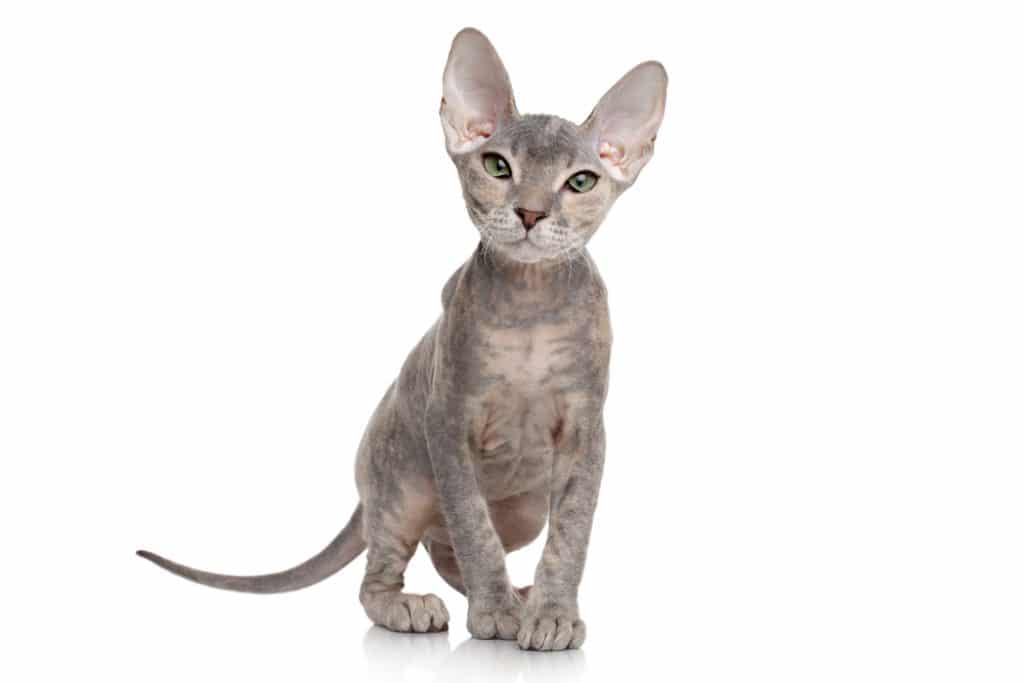
The Donskoy or Don Sphynx is a new breed that resulted from a spontaneous gene mutation, giving birth to the first truly hairless cat. The pedigree was first officially recognized by the WCF in 1997, gaining recognition for Championship Level in 2011 as Don Sphynx by FIFe and in 2016 under the Donskoy name by TICA. Not all cat registries recognize the Donskoy, because there are worries about their genetic health stating that the dominant genetic mutation of the breed causing the loss of hair in Donskoi could also cause feline ectodermal dysplasia, poor dentition, and compromise the ability to lactate or sweat of the cat.
The Donskoy is a very intriguing and unique social breed with soft hairless and cutely wrinkled skin that feels velvety to the touch. They are very active, friendly, soft-hearted, and highly intelligent, but also good-natured, gentle, and easy to groom.
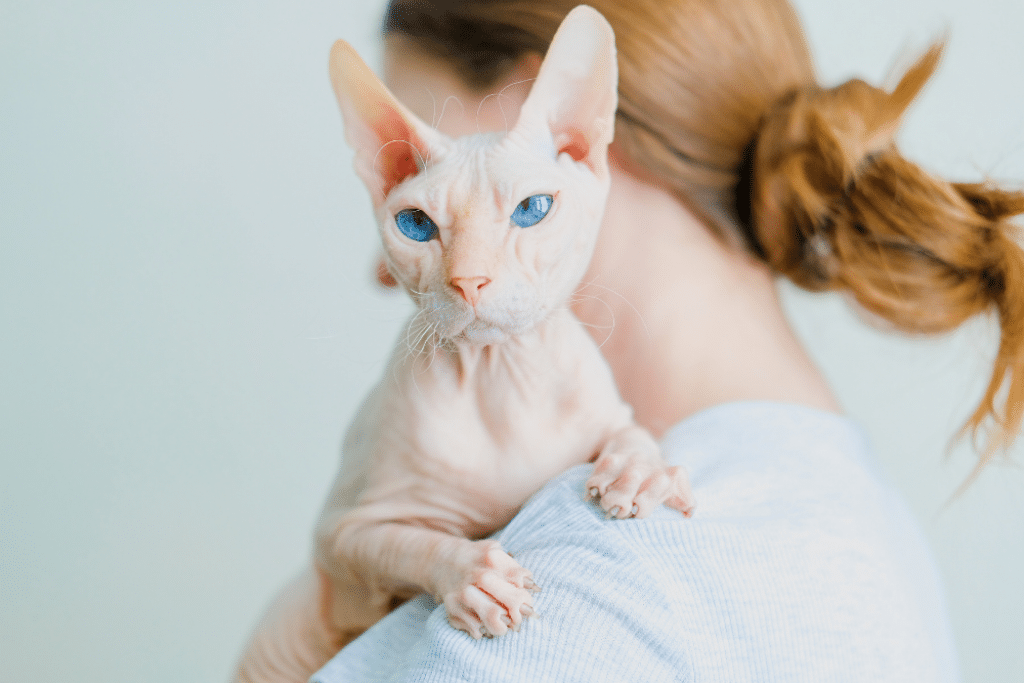
10. Burmilla

The Burmilla breed originated in the United Kingdom about 40 years ago in 1981 and is presently very rare in the USA.
Born from a ‘mistake’ of a cleaner leaving a door open, a beautiful Lilac Burmese female, named Fabergé escaped and mated with a Chinchilla Persian male cat named Jemari Sanquist (bought by Baroness Miranda Von Kirchberg as a present for her husband) although both cats were initially waiting to be mated in different rooms with a partner of their own breed. The offspring of the spontaneous interaction gave birth to a litter of 4 female kittens, all shorthair with a very attractive, black-shaded silver coat, kittens that became the progenitors of the Burmilla breed.
The breed has been fully accepted in GCCF (Governing Council of the Cat Fancy) since 2003 under the name Asian* accepting all coat color varieties for the Shorthaired coat length, but the Semi-Longhaired Burmillas are known as Tiffanie in GCCF. CFA granted Burmilla Championship recognition in 2014 and the breed gained Championship Status with TICA in 2015.

Burmillas are independent, sociable, very playful, and inquisitive, showing kitten-like behaviors even when adults, and are people-orientated and loving. A gentle family pet with a mischievous personality. Excellent companions that get along with other pets. They are good climbers and can learn tricks if given the chance.
See below our top 10 list of the rarest cat breeds in the World!

Top 4 newest cat breeds – still in development
This top contains all the new breeds in the experimental stage, that have registered and have been accepted by an important cat registry and gained a progressive recognition status or are still in an experimental stage, working their way towards full recognition.
1. Serengeti
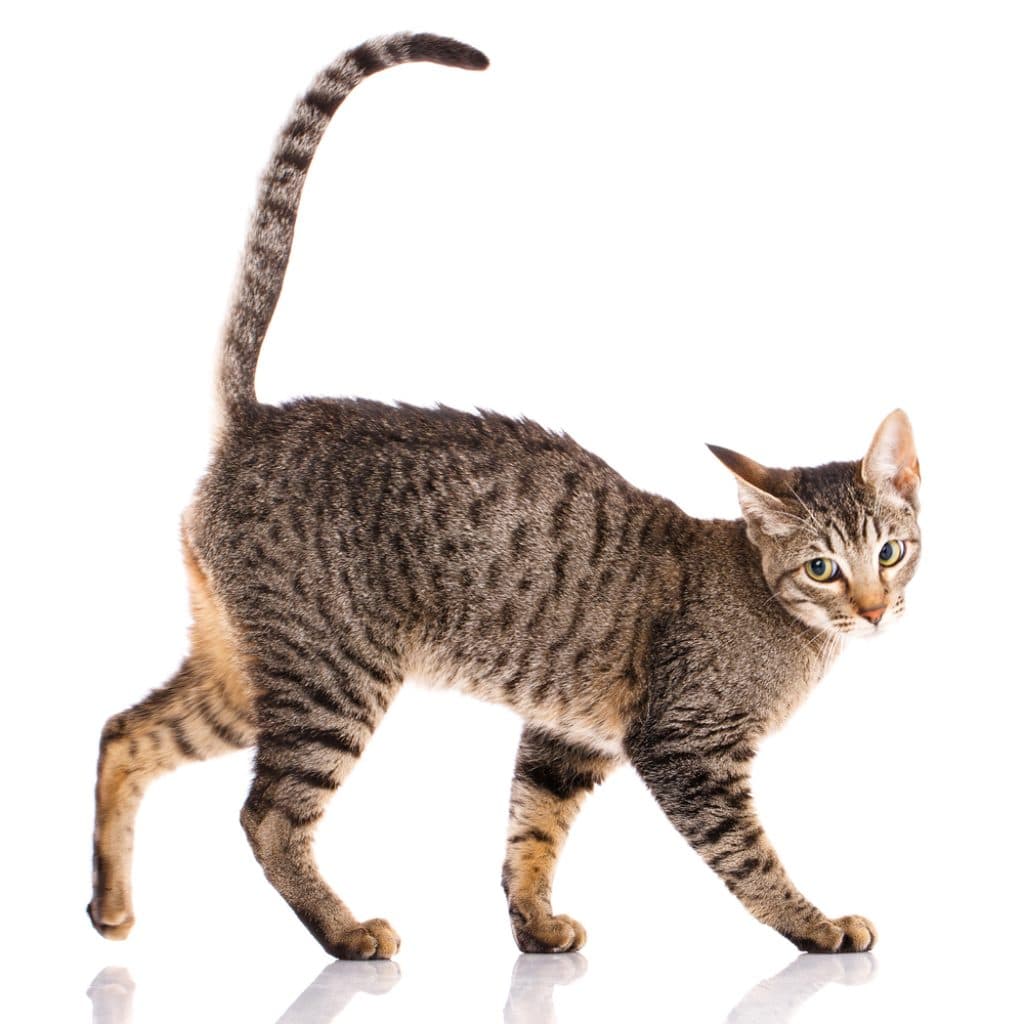
The Serengeti is a new cat breed still in its development stages with the foundation coming from crossing a Bengal (a hybrid with Asian Leopard genes) and an Oriental Shorthair (developed and related to the Siamese cats), aiming to produce a cat that looks similar to the beautiful African Serval, without using any recent wild Serval blood in the process, contrary to the Savannah breed.
Serengeti cats are spotted, with long legs and very large, round-tipped ears equal to the length of the head, also having as a main feature bright round eyes.
The breed is recognized and registered by TICA presently in the Advanced New Breeds level since 2018, with its tabby, ebony silver, ebony smoke, and solid black colors, currently working towards getting its snow spotted variety recognized, being one step away from full recognition with TICA. The Serengeti is also admitted as a Preliminary new breed by WCF.
Serengeti cats are loyal, gentle, confident, and outgoing felines with an agile temperament that loves to climb up cat trees and watch everything around them from a higher level, but as many other kitties do, they also like to run at high speeds around your home.
2. Highlander ( Short and Long-Haired)

The Highlander, originally known as the Highland Lynx, is an experimental new breed of cat with a unique appearance derived from a deliberate cross between the Desert Lynx and the Jungle Curl whose development began in 2004.
The key features of the Highlander are the upright curled ears with a slight turn backward. Highlanders can have a bobtail, full tail, or any other size in between. The coat is spotted or marbled covering a muscular big body. Some Highlanders have polydactyl paws. The breed presents no known health problems.

A gorgeous longhaired highlander with a long tail, and a distinctive and rare orange coat.
The Highlander breed comes in short and long hair coats, and both have been working towards championship status in TICA, both having in present the Advanced New Breeds status since 2016, which is the second level of the Championship Advancement Class Program of TICA, where they can be displayed in sanctioned shows but do not earn titles or points towards Annual Awards. The Highlander is also recognized by the Rare and Exotic Feline Registry (REFR) under the name Highland Lynx and admitted as a Preliminary breed by WCF.
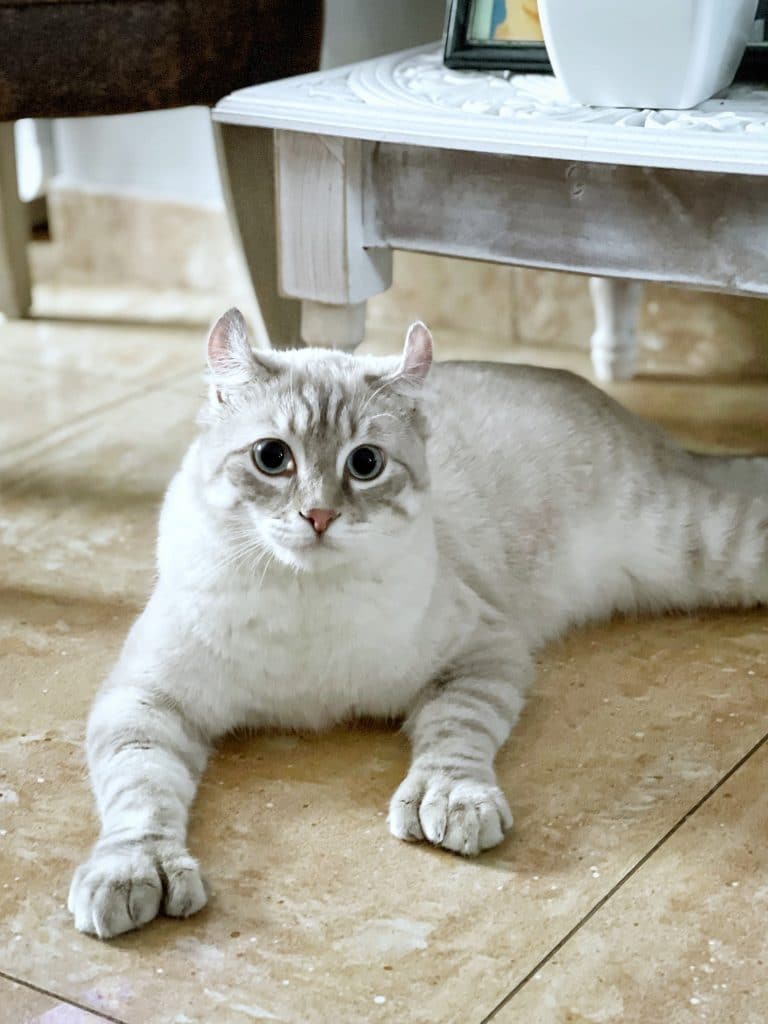
We chose Romeo’s sister to represent the highlanders with a more frequent coat pattern and also polydactyl paws.
Highlanders love to be the center of attention with their fun-loving nature and keep you entertained at all times and it is said they are fond of water.
3. Aphrodite / Aphrodite’s Giant
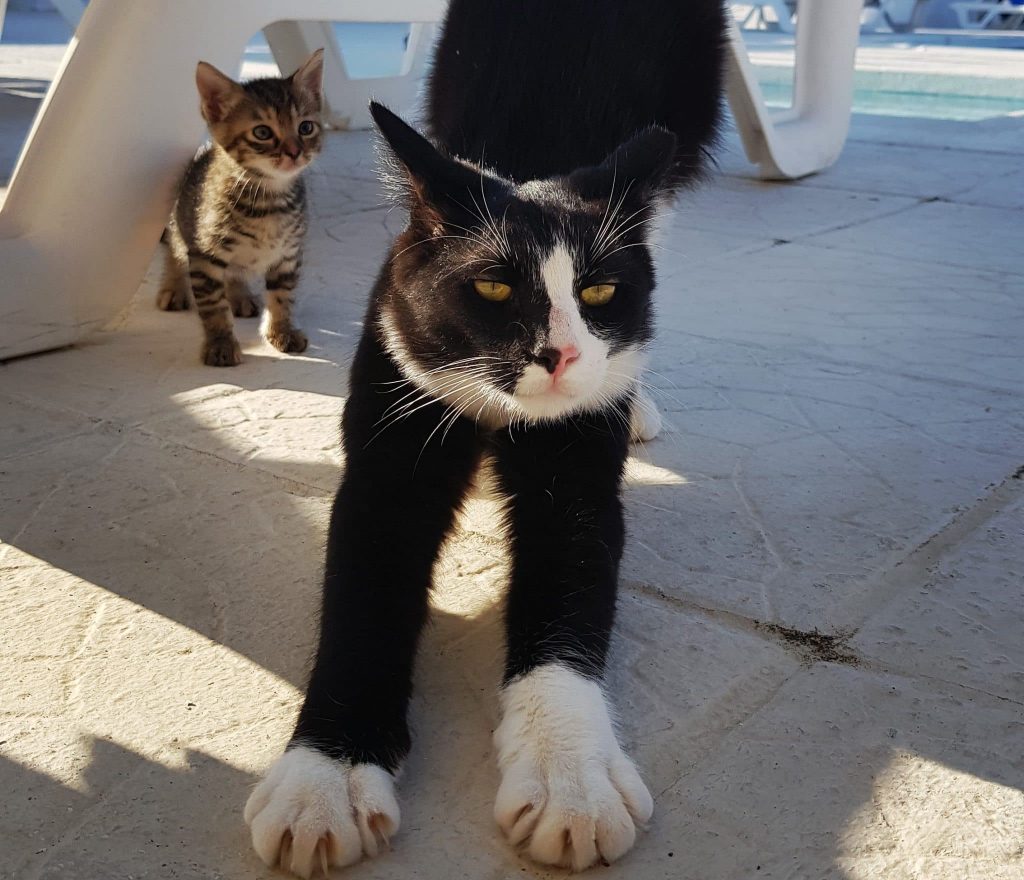
The Aphrodite breed, also known as Cyprus/Cypriot cat, Saint Helen cat, or Saint Nicholas cat is a naturally occurring breed found on the island of Cyprus and appears to have developed as a feral population in the mountains region, although now they are found across all the island. A more standardized pedigree is being developed from them with breeding regulated under the World Cat Congress (WCC) standards.
The breed has already achieved full recognition by WCF under the name of Aphrodite’s Giant in 2012 and is currently in the Provisionally New Breed level of TICA from 2017 with the Aphrodite Name
Aphrodite cats can be shorthaired or semi-longhaired and have any color and pattern (except colorpoint or mink). They are athletic, well-muscled, solid felines of medium to large build with hips and shoulders of the same width and the back legs slightly longer than the front ones. They have wide-set and fairly large ears forming an open V, and oblique, olive-shaped eyes of any color.
They are affectionate and social, taking about three to five years to mature and reach full size, and have dog-like behavior towards their owners.

This is a breed we take pride in and hope it will achieve a Championship status with TICA, as our babies Dobby and Dot are both rescued from the streets of Cyprus and both have all the features of the Aphrodite breed specified above!
4. Tennessee Rex

The Tennessee Rex is a natural mutation breed of cat discovered by Franklin Whittenburg in the first litter of kittens birthed by Satin Surprise, a stray cat he took home, that he found in his hometown, Chattanooga, Tennessee in 2004. Two red boys were unique with a recessive gene in the litter that causes curly glittering fur offering a satin look to the coat.
The breed is recognized by TICA as a Provisional New Breed, which is the beginning level of the Championship Advancement Class Program meaning they are eligible to be shown in sanctioned shows but can’t earn any awards.
There are few breeders now, and even TICA does not have full information about the breed on its official website yet.
In addition, if you are curious, I decided to round up some ‘older’ new cat breeds recognized by the major cat registries since the beginning of the 2000s. Are you ready?
Other recognized cat breeds since 2010
Since we know it’s very hard to discover or develop a new cat breed, this list covers the cat breeds that have been recognized by at least one major cat registry since the year 2010 but don’t qualify as a ‘new’ cat breed anymore.
1. Maine Coon Polydactyl

A Maine Coon Polydactyl is a Maine Coon cat with one or more extra toes on a paw that comes from a simple autosomal dominant gene and has no threat to the cat’s health. Many original Maine Coon cats used to possess extra toes, but now polydactylism is rarely seen in show rings as it was an automatic disqualifier not allowed by competition standards and almost got eradicated from the breed. Private organizations and breeders started to preserve polydactylism in Maine Coon cats, and now the variation is acceptable within general judging standards for the breed.
Only in TICA the Maine Coon Polydactyl variation is separately certified by the normal Maine Coon breed and accepted for Championship status since 2015.
Maine Coons are the perfect pet, known as the “gentle giants” of the cat’s world, despite their big size, they are sweet-tempered, intelligent, and friendly with a clownish personality willing to always ‘help’ their owners. They are easy to train, have a fascination with water, and are very vocal cats frequently yowling or howling, trilling, chirping, and making other loud vocalizations.
*All the breeds listed above are up to date since July 2022 and will be revised every time a new breed will emerge in the most important cat registries.
More experimental cat breeds, especially related to the Munchkin breed and accepted by smaller cat registries (mostly by the REFR and The Dwarf Cat Association) are the Toyger, Foldex, Genetta, Lambkin, Bambino, Kinkalow, Pantherette, Skookum/ LaMerm, Jungle, and The Jungle Curl, Dwelf, and many others.

But I will tell you more about them when it’s time and I’ve collected the correct info.
Before I end this article I thought you might want to know more about the types of new cat breeds and registries, so I’ve included some useful stuff and links to the most important cat registries out there.
What is a new cat breed?
A new cat breed is a breed in development progressing towards genetic stability and meeting the standards of pedigreed breeds to be accepted in one of the recognized cat registries of the world. There are 4 different types of new breeds:
- Natural: normally based on a genetic deviation from a domestic cat with a unique appearance that is naturally transmitted to their offspring for at least two generations. The last known and accepted new natural pedigree are the Lykoi.
- Designer breeds: these particular pedigrees are derived from mixing existing cat breeds, with the intention to have offspring that have the best characteristics of their parents. These mixes are not highly approved by cat registries, some do not even accept the registration. Last accepted were The Minuet and the Bambino.
- Line breeds: these new breeds are based on a specific look to create a new breed, sometimes the trait is taken from more than one different breed. The best example is the new Toyger breed that was bred to have a fur color pattern very similar to a tiger.
- Hybrid breeds: emerged from breeding a domestic cat with an exotic/wild cat where breeders hope to get the characteristics of the exotic cat and suppress their wild behavior with domesticated genes. This type of new breed is also highly debated by cat fanciers because sometimes the offspring or such attempt looks nothing like the breeder expected nor meets the behavioral expectations. A good example of an excepted hybrid breed is the Savannah, a cross between a domestic cat and a serval.
Many new breeds raise concerns related to health problems and temperament, so it does not matter how a breed will eventually look, if it is not healthy and can not behave like a companion, and so, it shouldn’t continue being bred. All the new breeds are evaluated for many years before being accepted as a pedigree to eliminate such concerns. Some of the new experimental breeds never get recognition as they do not meet the breed standards.
What is a cat Championship breed?
A Cat Championship Breed is a breed entitled to participate and earn awards in Annual Awards and Cat Shows and Exhibitions organized by Cat registries around the world, competing along with other pedigreed cats for best breed titles. All registries have different guidelines for awarding championship levels (age, weight, health, etc.), and new breeds take years to develop and earn such a status.
What is a Cat Breed Registry?
A cat breed registry is an organization, federation, or association of cat breeders and breeding catteries that registers domestic cat breeds, normally purebred, for exhibition purposes (shows) or tracking the breeding ancestry of a pedigree. A registry keeps track of the cat breed genealogies, the names of the breeding catteries and studs (the registered animal retained for breeding), descriptive lists of the recognized pedigrees, the breed standards they work by, and the judges sanctioned to award titles in exhibitions.
Each registry works by its own rules and recognition levels for accepting new breeds. Normally the recognition levels start with the registration level ( where a cat breed can be registered but not exhibited in shows), the exhibition only (a breed from a variety that does not compete but can be exhibited to attract new breeders), or experimental ( still in development) working their way to the provisional or preliminary level (where the breed is recognized but still need to prove it meets the registered standards, this level can also be in a new or advanced class of its own in different breed registries) and finally the full or championship level ( the breed is fully recognized and can compete for titles in shows).
Which is the most relevant cat breed registry?
All cat registries are relevant depending on the side of the world you live in, but The International Cat Association (TICA) is the most progressive genetic registry of pedigreed and domestic cats today, with 73 recognized cat breeds for championship competition, 3 advanced new breeds, and 3 preliminary new breeds. TICA recognizes pedigrees derived from mixing or mutations of existing breeds, naturally occurring lineages native to a geographical area, or a breed already recognized by another cat registry, whilst other organizations are more ‘traditional’ in their acceptance of new breeds.
Other relevant cat registries, accepted by WCC – World Cat Congress are:
- Cat Fanciers Association (CFA) with 42 recognized breeds for championship status and three breeds in the Miscellaneous class.
- Fédération Internationale Féline (FIFe) has 48 fully recognized pedigrees and 1 preliminary breed in the varieties section and they have established procedures for new breeds to gain full recognition even if they are imported from other cat registries.
- The Governing Council of the Cat Fancy (GCCF) based in the United Kingdom is known to be more conservative and slow in accepting new breeds, not recognizing mutations of an existing breed, but accepting new color variations. It has 40 recognized pedigrees, including one preliminary.
- Canadian Cat Association – in French: Association Féline Canadienne (CCA-AFC),
- World Cat Federation (WCF) based in Germany with 68 recognized breeds, 39 admitted breeds, and 8 preliminary breeds
- Rare and Exotic Feline Registry ( REFR) that specializes in hybrid mixes;
- The Dwarf Cat Association (TDCA) works with the development of dwarf cats and strives for recognition but they are not widely accepted by other registries outside the United States and I suspect have been dissolved.
So what is your favorite new cat breed? Let me know in the comments below.
Have a pawesome day!








Me encanta tu blog y creo que muchas de tus publicaciones son justo lo que estoy buscando. ¿Puede ofrecer a escritores invitados que escriban contenido para usted personalmente? No me importaría producir una publicación o desarrollar algunos de los temas sobre los que escribe aquí. Una vez más, ¡weblog increíble!
hola, muchas gracias por su interés pero, lamentablemente, ya tenemos un escritor de blog
I love cats so much I could squeeze them all to death (i don’t mean the death part)